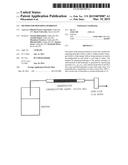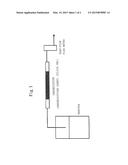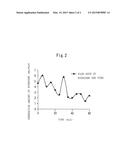Patent application title: METHOD FOR PREPARING HYDROGEN
Inventors:
Susumu Hikazudani (Osaka-Shi, JP)
Susumu Hikazudani (Osaka-Shi, JP)
Atsushi Wakui (Osaka-Shi, JP)
Masaharu Furutera (Osaka-Shi, JP)
Hitoshi Oshiro (Osaka-Shi, JP)
Tetsuya Inoue (Osaka-Shi, JP)
Kazuyuki Hirao (Kyoto-Shi, JP)
IPC8 Class: AC01B306FI
USPC Class:
423657
Class name: Hydrogen or compound thereof elemental hydrogen by reacting water or aqueous solution with metal or compound thereof
Publication date: 2015-03-19
Patent application number: 20150078987
Abstract:
One object of the present invention is to provide a method for preparing
hydrogen which is able to simply produce hydrogen which is clean energy
without using ammonia as used in the background art and which is very
high in safety. The method for preparing hydrogen of the present
invention is characterized in that hydrogen is generated by introducing
mayenite (Ca12Al14O33) and calcium hydroxide
[Ca(OH)2] into water and allowing them to react with water. Here, it
is preferable that a temperature of water is from 50 to 100° C.,
and a molar ratio of mayenite to calcium hydroxide is 1/9.Claims:
1. A method for preparing hydrogen, which is characterized in that
hydrogen is generated by introducing mayenite
(Ca12Al14O33) and calcium hydroxide [Ca(OH)2] into
water and allowing them to react with water.
2. The method for preparing hydrogen according to claim 1, which is characterized in that a temperature of water is from 50 to 100.degree. C., and a molar ratio of mayenite to calcium hydroxide is 1/9.
Description:
TECHNICAL FIELD
[0001] The present invention relates to a method for preparing hydrogen.
BACKGROUND ART
[0002] In recent years, a number of proposals of using, as an energy source, hydrogen that is clean energy have been made, and for example, development of automobiles to be driven by a fuel cell using hydrogen as a fuel is conducted. An exhaust gas from a fuel cell using hydrogen as a fuel does not contain nitrogen oxides, particulate matters, carbon dioxide, and the like which are contained in an exhaust gas from an internal combustion engine, and hence, such a fuel cell is watched as a clean power source capable of suppressing environmental pollution and global warming.
[0003] However, a volume in storing hydrogen is large, and for example, in a fuel cell for automobile, a supply means of hydrogen that is the fuel is of a problem.
[0004] The following Patent Document 1 discloses a method for generating hydrogen by decomposing ammonia or the like and describes an apparatus for generating hydrogen for fuel cell having a decomposer of decomposing a hydrogen source composed of ammonia and/or hydrazine into nitrogen and hydrogen by a catalytic reaction and supplying them into a fuel cell; and furthermore, the following Patent Document 2 describes a hydrogen generating apparatus for efficiently generating hydrogen from ammonia, in which the invention of Patent Document 1 is improved, and a hydrogen generating method.
[0005] Meanwhile, miniaturization of a fuel cell per se is demanded, and this is aimed at utilization in place of an AC-De convertor of a charging type secondary cell which is used for mobile phones, PDA (personal digital assistant), digital cameras, notebook personal computers, and the like.
BACKGROUND ART DOCUMENT
Patent Document
[0006] Patent Document 1: JP-A-2003-40602
[0007] Patent Document 2: JP-A-2010-241647
SUMMARY OF THE INVENTION
Problems to be Solved by the Invention
[0008] However, in the conventional method of producing hydrogen by a catalytic reaction of ammonia described in the above-described Patent Documents 1 and 2, ammonia is one of the specified offensive odor substances stipulated in the Offensive Odor Control Law and is also designated as a deleterious substance in the Poisonous and Deleterious Substances Control Law, and therefore, there was involved such a problem that handling of ammonia is very troublesome.
[0009] An object of the present invention is to solve the above-described problem of the background art and to provide a method for preparing hydrogen which is able to simply produce hydrogen which is clean energy without using ammonia as used in the background art and which is very high in safety.
[0010] In addition, the object of the present invention is to provide a method for preparing hydrogen which is able to miniaturize a fuel cell per se using hydrogen which is clean energy and which is also applicable to a fuel cell capable of being utilized in place of an AC-DC convertor of a charging type secondary cell which is, for example, used for mobile phones, PDA (personal digital assistant), digital cameras, notebook personal computers, and the like.
Means for Solving the Problem
[0011] In order to attain the foregoing object, an invention of a method for preparing hydrogen of claim 1 is characterized in that hydrogen is generated by introducing mayenite (Ca12Al14O33) and calcium hydroxide [Ca(OH)2] into water and allowing them to react with water.
[0012] An invention of claim 2 is concerned with the method for preparing hydrogen according to claim 1, which is characterized in that a temperature of water is from 50 to 100° C., and a molar ratio of mayenite to calcium hydroxide is 1/9.
EFFECTS OF THE INVENTION
[0013] The invention of the method for preparing hydrogen of claim 1 is characterized in that hydrogen is generated by introducing mayenite and calcium hydroxide into water and allowing them to react with water, and according to the invention of claim 1, there give rise to such effects that hydrogen which is clean energy can be simply prepared without using ammonia as used in the background art; and that safety is very high.
[0014] In addition, according to the method for preparing hydrogen of the present invention, there give rise to such effects that a fuel cell per se using hydrogen which is clean energy can be miniaturized; and that the method for preparing hydrogen of the present invention is also applicable to a fuel cell capable of being utilized in place of an AC-DC convertor of a charging type secondary cell which is, for example, used for mobile phones, PDA (personal digital assistant), digital cameras, notebook personal computers, and the like.
[0015] The invention of claim 2 is concerned with the method for preparing hydrogen according to claim 1, which is characterized in that a temperature of water is from 50 to 100° C., and a molar ratio of mayenite to calcium hydroxide is 1/9, and according to the invention of claim 2, there gives rise to such an effect that hydrogen can be efficiently prepared from mayenite and calcium hydroxide.
BRIEF DESCRIPTION OF THE DRAWINGS
[0016] FIG. 1 is a diagrammatic flow sheet showing an example of a testing apparatus for hydrogen production in which the method for preparing hydrogen of the present invention was carried out.
[0017] FIG. 2 is a graph showing a change with time of hydrogen generation rate in a hydrogen production test in which the method for preparing hydrogen of the present invention was carried out.
MODES FOR CARRYING OUT THE INVENTION
[0018] Next, embodiments of the present invention are described, but it should not be construed that the present invention is limited thereto.
[0019] The method for preparing hydrogen according to the present invention is characterized in that hydrogen is generated by introducing mayenite (Ca12Al14O33) and calcium hydroxide [Ca(OH)2] into water and allowing them to react with water.
[0020] As described above, when mayenite and calcium hydroxide are introduced into water and allowed to react with water, katoite [Ca3Al2(OH)12] and hydrogen (H2) are generated according to the following reaction formula.
Ca12Al14O33-x9Ca(OH)2+(33+x)H2O→7Ca3Al2(OH)12+xH2
[0021] In the method for preparing hydrogen according to the present invention, it is preferable that a temperature of water is from 50 to 100° C., and a molar ratio of mayenite to calcium hydroxide is 1/9.
[0022] Here, when the temperature of water in the method for preparing hydrogen is lower than 50° C., not only a rate of hydrogen generation reaction becomes slow, but the yield becomes poor, and hence, such is not preferable. It is to be noted that in the generation reaction of hydrogen, the temperature of water does not exceed 100° C.
[0023] According to the method for preparing hydrogen of the present invention, it is possible to simply produce hydrogen which is clean energy without using ammonia as used in the background art. Then, since both of mayenite and calcium hydroxide are a non-poisonous powdered or granulated substance, they are easy in handling and very high in safety.
[0024] In addition, according to the method for preparing hydrogen of the present invention, a fuel cell per se using hydrogen which is clean energy can be miniaturized, and the method for preparing hydrogen of the present invention is also applicable to a fuel cell capable of being utilized in place of an AC-DC convertor of a charging type secondary cell which is, for example, used for mobile phones, PDA (personal digital assistant), digital cameras, notebook personal computers, and the like.
EXAMPLES
[0025] Next, the Example of the present invention is described together with the Comparative Examples, but it should not be construed that the present invention is limited to these Examples.
Example 1
[0026] The method for preparing hydrogen according to the present invention was carried out by using a testing apparatus for hydrogen production shown in FIG. 1.
[0027] First of all, 200 mL of ion exchange water was charged in a reactor (separable flask) having a capacity of one liter. Subsequently, 9 g of an aluminum powder (a trade name: #150, manufactured by Minalco Ltd.) and 12 g of calcium hydroxide [Ca(OH)2] (manufactured by Wako Pure Chemical Industries, Ltd.) were introduced into the reactor, followed by stirring. After completion of generation of a hydrogen gas, the ion exchange water was removed by filtration, and the remaining solid was dried in air at a temperature of 70° C.
[0028] The obtained solid was katoite, and when this was baked in air at a temperature of 300° C. for 2 hours, mayenite (Ca12Al14O33) and calcium hydroxide were generated.
[0029] 200 mL of ion exchange water was charged in a reactor (separable flask) having a capacity of one liter. Subsequently, 9 g of the above-obtained mixture of mayenite (Ca12Al14O33) and calcium hydroxide [Ca(OH)2] (molar ratio: 1/9) was introduced into the reactor, followed by stirring. The temperature was raised to set up a temperature of the ion exchange water to 55° C. The mayenite and calcium hydroxide were allowed to react with water, thereby generating hydrogen. The hydrogen gas was allowed to pass through a dehumidifier filled with a silica gel as a dehumidifying agent to remove water, and a generation amount thereof was then measured by a soap-film flow meter. A component of the generated gas was analyzed by a TCD (thermal conductivity detecter) type gas chromatograph (a trade name: GC-8A, manufactured by Shimadzu Corporation) and confirmed to be hydrogen. It could be confirmed that the hydrogen gas was generated over 60 minutes after the ion exchange water had reached the prescribed temperature. A change with time of hydrogen generation rate in this case is shown in FIG. 2. The generation amount of the hydrogen gas over about 60 minutes was about 300 mL.
[0030] Here, when mayenite and calcium hydroxide were introduced into water and allowed to react with water, katoite [Ca3Al2(OH)12] and hydrogen (H2) were generated according to the following reaction formula.
Ca12Al14O33-x+9Ca(OH)2+(33+x)H2O→7Ca.sub- .3Al2(OH)12+xH2
[0031] From this fact, according to the method for preparing hydrogen of the present invention, hydrogen which is clean energy could be simply prepared without using ammonia as used in the background art, and safety was very high. In addition, according to the method for preparing hydrogen of the present invention, it became clear that a fuel cell per Se using hydrogen which is clean energy can be miniaturized, and the method for preparing hydrogen of the present invention is also applicable to a fuel cell capable of being utilized in place of an AC-DC convertor of a charging type secondary cell which is, for example, used for mobile phones, PDA (personal digital assistant), digital cameras, notebook personal computers, and the like.
Comparative Examples 1 and 2
[0032] For comparison, the following experiments were conducted. In Comparative Example 1, 200 mL of ion exchange water was charged in the same reactor (separable flask) as that in the case of Example 1, and subsequently, only mayenite was introduced into the reactor. Although the temperature was raised to set up a temperature of the ion exchange water to 55° C., a reaction did not take place, and generation of a hydrogen gas was not confirmed. In addition, in Comparative Example 2, 200 mL of ion exchange water was charged in the same reactor as that in the case of Example 1, and subsequently, only calcium hydroxide was introduced into the reactor. Although the temperature was raised to set up a temperature of the ion exchange water to 55° C., a reaction did not take place, and generation of a hydrogen gas was not confirmed.
User Contributions:
Comment about this patent or add new information about this topic:



